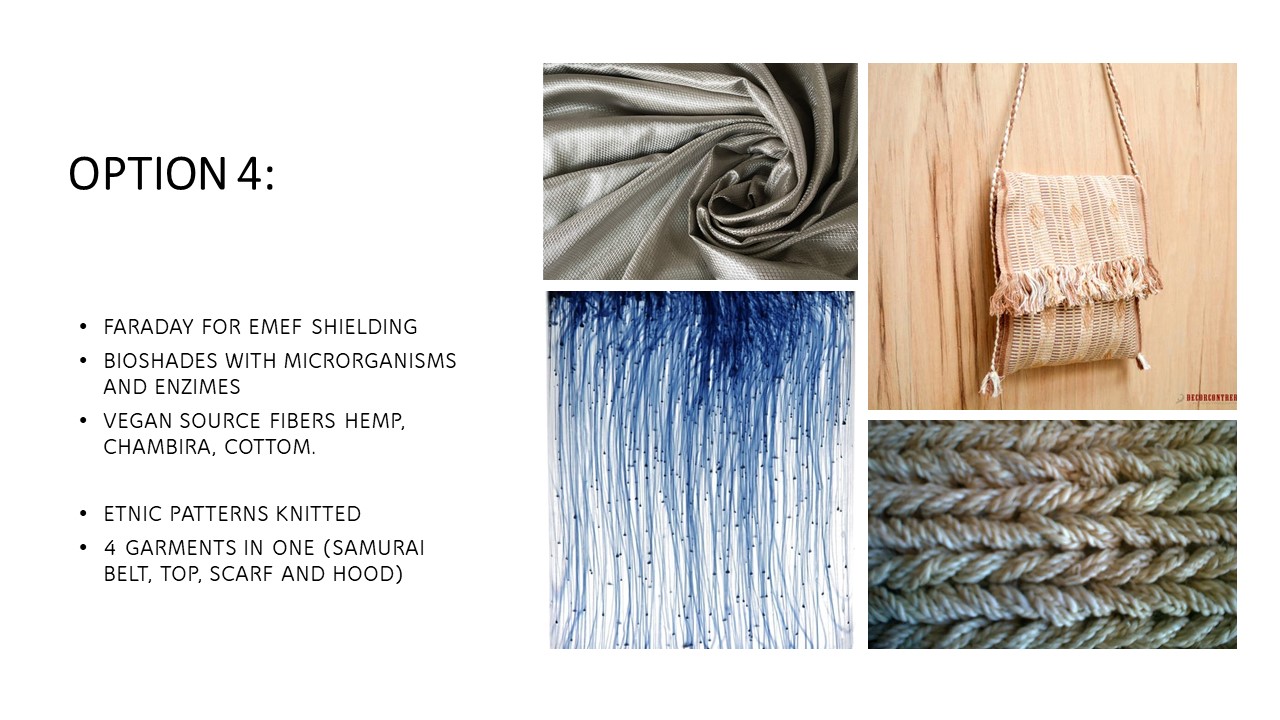Final Project: Mashwa's Shielding Collection Garment¶
"Everything must always hide its relationship with Everything. You just have to deserve it, to discover the hidden nexus, the dark springs, the invisible thread of things and facts and people".
"Everything is related to Everything. And more here in the Jungle. The Shipibo are soul portraitists". Las Tres Mitades de INO MOXO by Cesar Calvo.
Research¶
I started my research process by designing a brief survey about current awareness of Shielding Collections in the market. The results were as follows: Since on Feb 11, 2020 only a total of 12 potential customers had filled the below survey, I decided to wait for a couple of more weeks so i could get a more accurate result. So far whomever heard about a Shielding Collection had a very positive feedback although they were not willing to pay more than 150 euros for a Shielding Garment. Another interesting findings were that the most important features were definitely DURABILITY, DESIGN, SUSTAINABLE MATERIALS and FIT AND SUSTAINABLE PROCESSES. And in regards of the most wanted SHIELDING FEATURES the interviewer preferred Noise, Air Pollution and EMF Shielding.


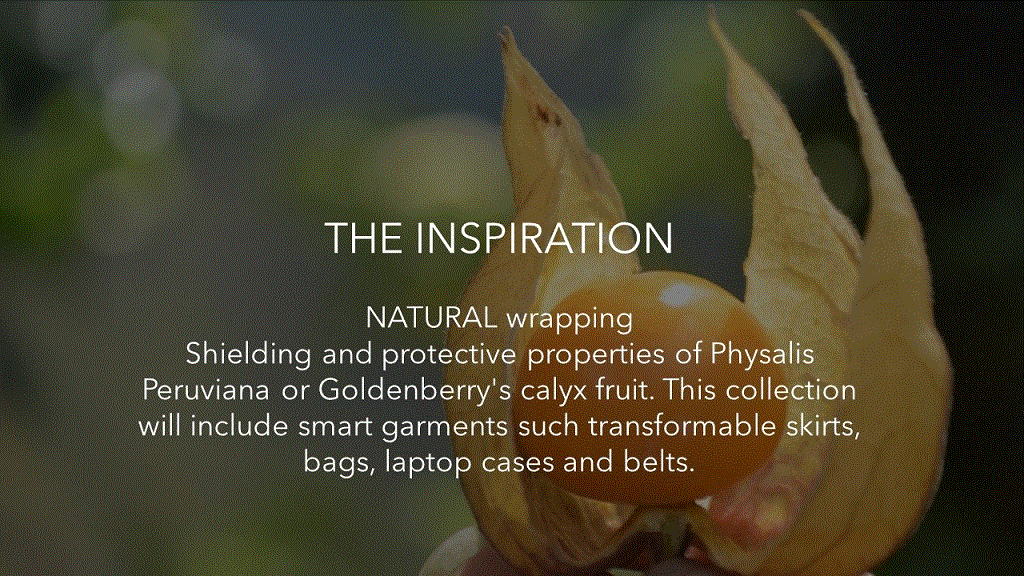

- Market Research Survey made in Survey Monkey
- PILI Bioshares with microorganisms and enzimes
- Digital Wax Print
- Advantages of Sublimation of Fabrics
- A Color-Changing Shirt That Detects Air Pollution
- Colorimetric Gas Sensing Washable Threads for Smart Textiles
- Clothing May Soon Be Able to Change Color in the Presence of Harmful Gases
- Color-Changing Shirts Visualize Polluted Air
- Westmed CO2 Easy Carbon Dioxide Detector
- Bacteria to spot pollution
- Indicator bacteria
- Noumena
- Detecting Pollution with Living Biosensors
- Bacterial Biosensors for Measuring Availability of Environmental Pollutants
- NANOSILVER-AN EFFECTIVE ANTIMICROBIAL AGENT FOR FINISHING OF TEXTILE
- Textiles for Protection by Richard A. Scott
- Nanofiber technology: current status and emerging developments
- WHO 2012 Nanofibers Report
- Nanosilver: safety, health and environmental effects and role in antimicrobial resistance, SCENIHR 2014
- ELSEVIER Nanofiber technology: current status and emerging developments
Our options with existing and upcoming technology¶
Initially I noticed that I could go for 4 different options for the creation of the Minimum Value product of the Shielding Collection, but them
I decided to go for the FIRST, SECOND and FOURTH options. Although for the SECOND OPTION the organic pattern will not be created by upcycling
denim textiles and will apply a Tessellation of organic patterns inspired in Peruvian Biodiversity.
The THIRD OPTION was not considered because It was not close to the main expectations the interviewers had chosen as required features and also because
Digital Waxing involved the creation of an additional Open Source Hardware which could extend the deadlines of the current project.
Another challenge I found on the way, was to work with the closest materials I will be able to find in Peru and Spain, since PROXIMITY to the producers and their materials is key for offering a sustainable shielding collection.
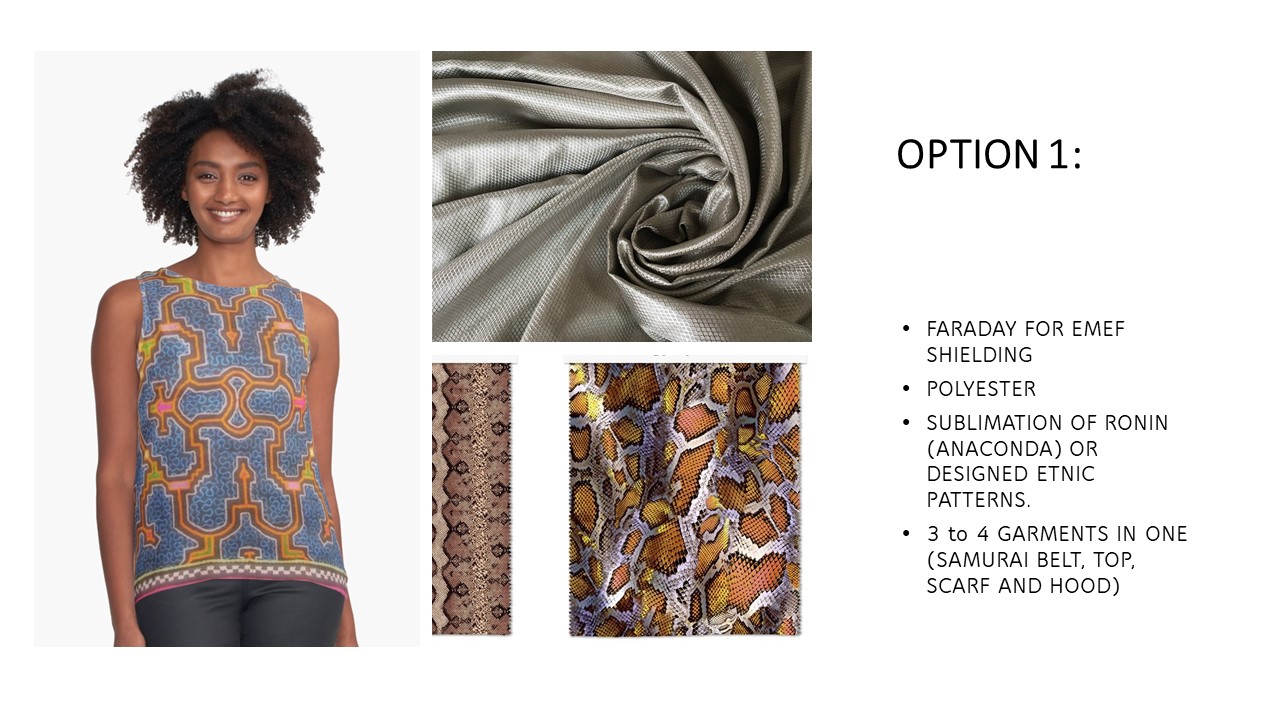
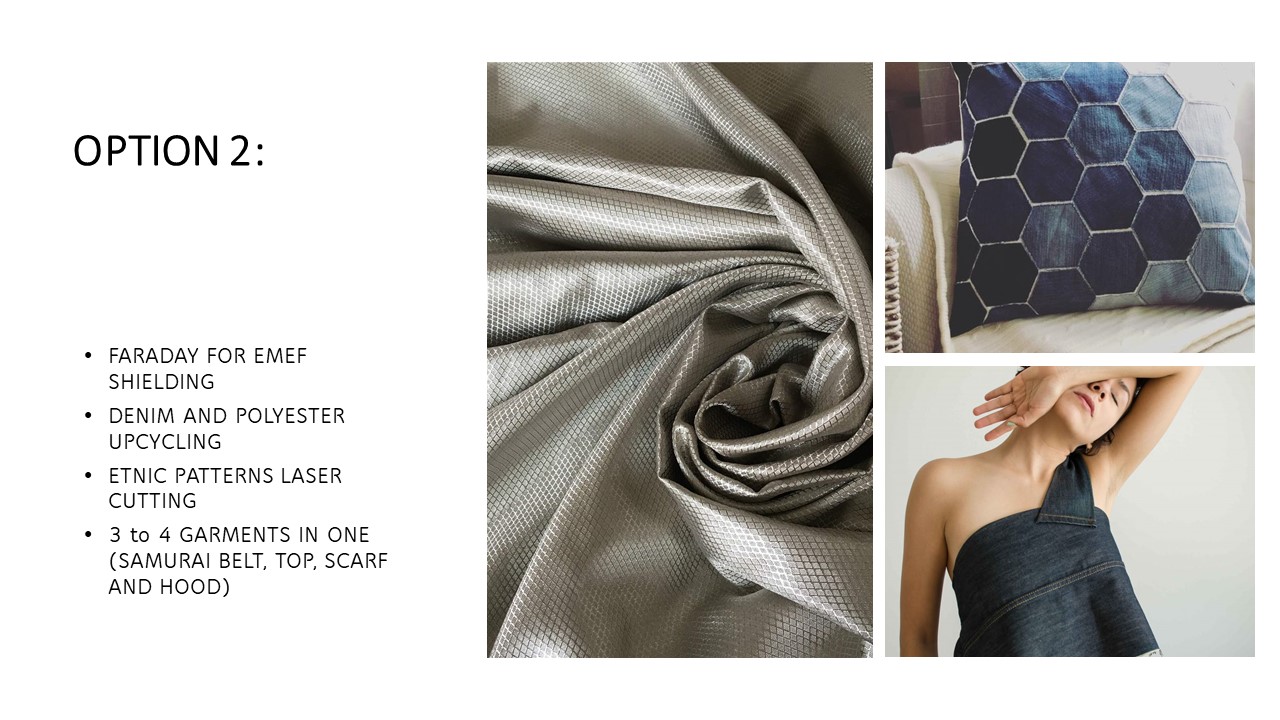
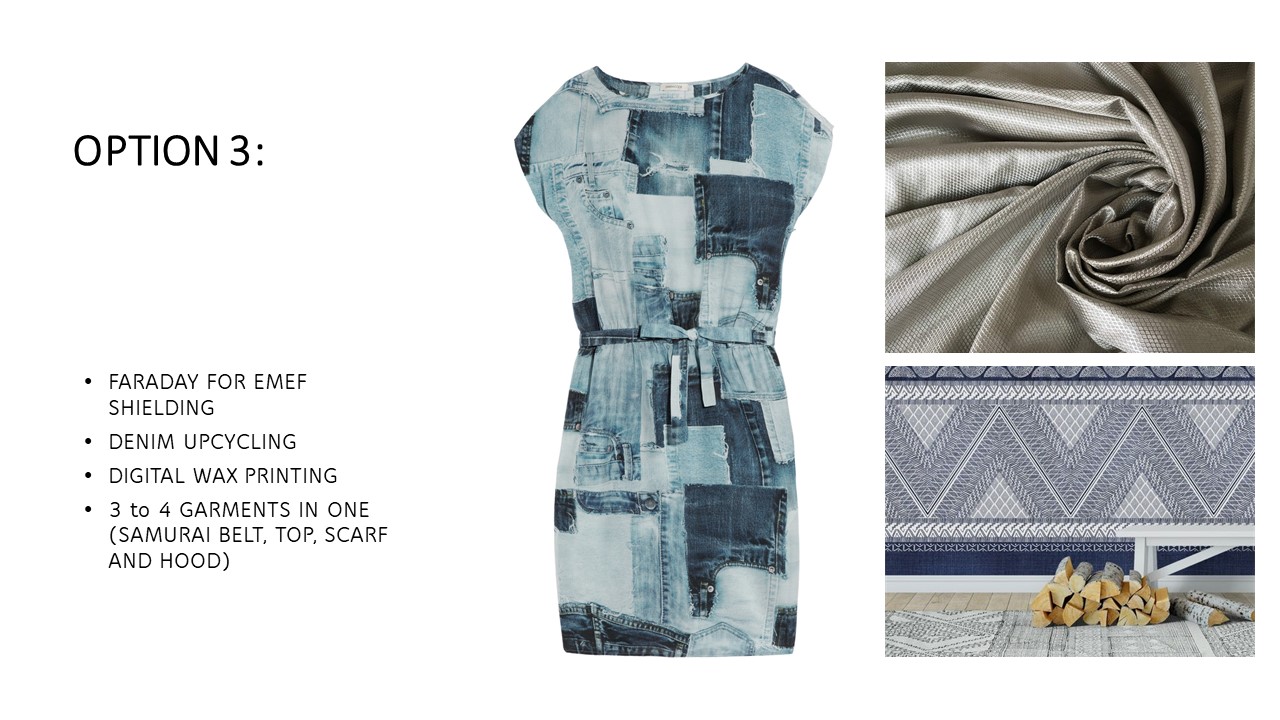
The Prototyping Process¶
The BEGINNING prototyping in a tradidional way and the END will be getting a DIGITAL DATA SHEET Prototype that can be adapted to each market where the MINIMUM VALUE GARMENT could be produced and commercialized. The prototyping process began with the definition of the minimum characteristics of each garment that was to be part of the collection. I could Identify the following specifications: multifunctionality, awareness, minimalism and adaptation of the ancestral to the contemporary. Therefore, I decided to start with a conventional pattern of the basic garment of the collection (The Minimum Value Product), which will then be digitized with the help of the digital tools learned in the FabAcademy Textile, then that same garment will have 3 versions (3 different markets): Low Cost Garment, whom are not willing to pay more than 100 euros (Sublimation in Polyester), Medium Cost Garment, the cost will range between 100 and 150 euros and It will be developed with Tessellation inspired by organic and geometric patterns in natural wool felt and a High Cost Garment whose cost will be greater than 200 euros made of fabric of vegetable fibers and stained with microorganisms.
Materials¶
- Polyester for sublimation tecnique
- Felt
- Organic Cottom Fabric
- Silver Jersey Knit Fabric Cat. #1281
- Serratia Marcescens Bacteria
- High Definition Photos of Peruvian Biodiversity (provided by PROMPERU - DIGITAL PHOTOS archives).
- Nanofibers
- Silver Nanofibers Health and Safety Research Studies
Selection of Shielding Textile¶
After evaluating our main options. I came to the conclusion that for the 03 MINIMUM VALUE GARMENT PROTOTYPES, since the Shielding Textiles was going to be cover by the other textiles I could used, then ELASTICITY was a required specification for this conductive and shielding material, therefore I opted for the Silver Jersey Fabric Cat. 1281 provided by Lessemf US Company. I found that this material had a high shielding levels, It was Washable, comfortable, and safe for skin contact. Although currently the use of Nanofibers has been placed on the table for its possible human health and safety possible impacts (Between 2008 and 2012 researchers suggested that nanofibers were a high a health risk as asbestos). The WHO 2008 Report indicated that there are currently no definitive conclusions on the best metric. However, there is consensus that there should be sufficient characterization of the forms of a substance tested to allow the dose response to be expressed in the different metrics discussed: number, surface area and mass. It is important to note that there are other parameters that can act as modifiers of the toxicity, including particle size, size distribution, density, surface modification, aggregation and agglomeration state, and shape, but these parameters would not generally be considered as scalable quantities. They do not appear to conform to the current use of the term “metric” under REACH, and were therefore not considered further in relation to the metric issue. Therefore, in order to make a proper selection of the Nanofiber we must make sure it meets the EU requirements and technical protocols and LTV's.
According to American Conference of Governmental Industrial Hygienists, the exposure to any substance including nanomaterials depends on the amount present in a product and the possibility for release or leakage out of the product. To estimate exposure levels, information is needed on the concentrations of Ag-NPs in the product, the size and the form in which it is present (aggregates, agglomerates) and the probability of release of (nano) Ag+ from the product. The availability of these data is limited for the moment: reported levels of silver released from silver-containing consumer products in different studies are inconsistent, which is probably due to differences in methodology used. Measurements of nanomaterials in consumer products are therefore urgently needed. In order to evaluate human exposure to Ag-NP, a simple categorization of exposure possibilities to Ag-NPs in products as proposed by Hansen et al. (2008) may be helpful. The categorization includes: Expected to cause exposure, May cause exposure, and Not expected exposure to the consumer. The type of product (spray, liquid, solid) largely determines the likelihood for exposure. However, reported levels of silver released from silver-containing consumer products in different studies are inconsistent, which is probably due to differences in methodology used. Occupational exposure to silver and silver particles –mainly via airborne material – has not been studied in full detail. A further detailed description of the occupational exposure is needed in order to perform an occupational risk assessment.
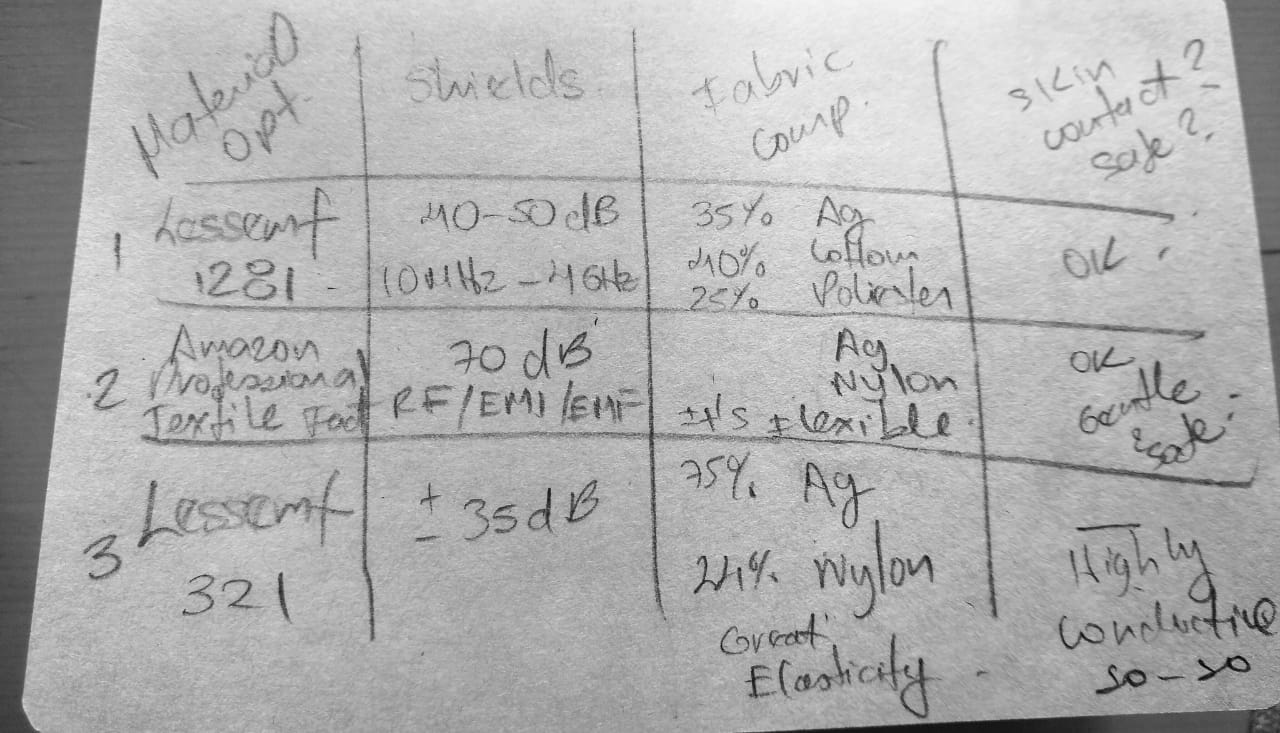
| Qty | Description | Price | Link | Notes |
|---|---|---|---|---|
| 1 | Material one | 22.00 $ | http://amazon.com/test | Order many |
| 1 | Material two | 22.00 $ | http://amazon.com/test | |
| 1 | Material three | 22.00 $ | http://amazon.com/test | |
| 1 | Material five | 22.00 $ | http://amazon.com/test | |
| 1 | Material eight | 22.00 $ | http://amazon.com/test | |
| 1 | Material twelve | 22.00 $ | http://amazon.com/test | |
| 1 | Material eleven | 22.00 $ | http://amazon.com/test |
FINAL PROTOTYPES DEVELOPMENT¶
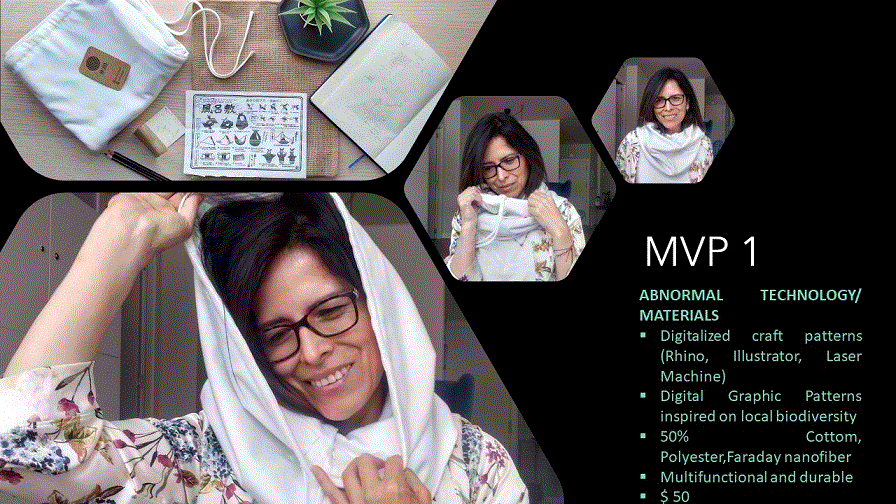
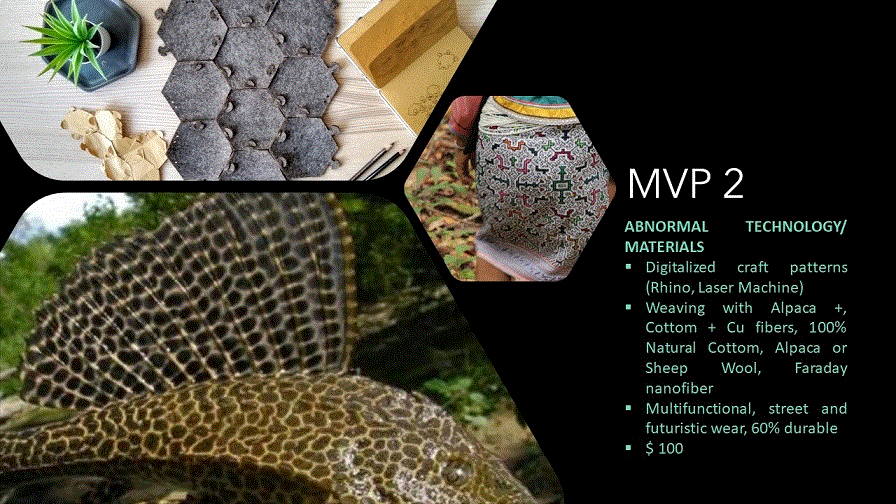
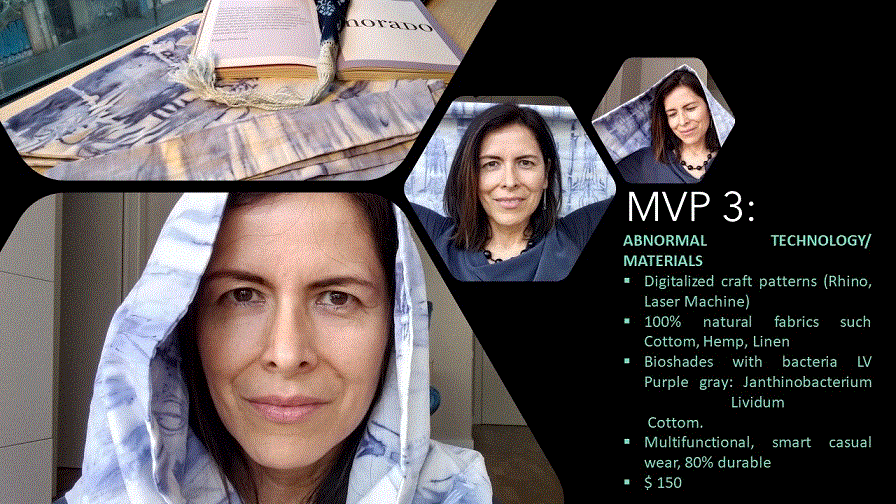
Shielding Collection Intro¶
Shielding Collection Prototype 4 Intro¶
Mashwa MVP3 Short Storytelling 2 from Majavierr on Vimeo.
Shielding Collection STORYTELLING Final¶
MashwaShieldingCollectionFINAL from Majavierr on Vimeo.
